Do-it-yourself water well setup: how to properly equip a water source
To protect the well and equipment from external pollution, atmospheric phenomena and vandals, it must be properly equipped. Agree, comfort when using the water intake, maintenance of equipment and the pipeline is as important as its safety. How to protect, ensuring ease of use?
Those who wish to conduct a well installation on water with their own hands will tell you how to do it competently. Let’s show you which option is better to choose for your source. Here you will learn how to build a caisson for a wellhead yourself, how to install an adapter, and also where to place a hydraulic accumulator.
A detailed description of the methods and technologies for equipping a personal hydraulic structure is based on regulatory documents and the experience of well owners. The information presented for acquaintance is supplemented by visual schemes, collections of photos, video manuals.
The content of the article:
Why do I need to equip a well?
After the well has been drilled and before the water supply in the house is fed from it, the source is arranged, the water supply equipment is selected and installed.
What tasks does the arrangement of a water well solve:
- Ensuring the purity of the source. Do not allow contaminants to enter the well from the surface: dust, rain or melt water.
- Protection of the water supply, equipment and piping from freezing.
- Formation of conditions for connecting and servicing equipment.
Water supply equipment (except submersible pump) can be installed both in the house and near the well. In the latter case, it is necessary to have a technical room at the wellhead with a sufficient area where this equipment will be installed.
But even when installing it in a house, it is very convenient to have a small room at the outlet of the pipeline from the well, this greatly facilitates pump installation and its service. Putting a water pipe into the well, as well as supplying power for the submersible pump, is also carried out at the construction stage.
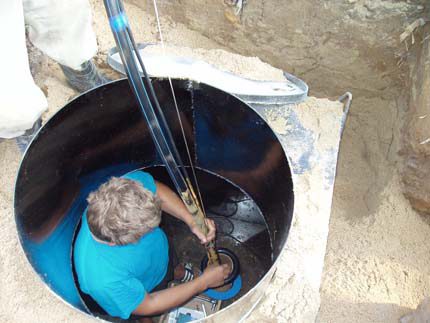
Selection and installation of equipment for the supply of water
Equipment for individual water supply consists of the following elements:
- Pump, it can be submersible or located on the surface.
- Automaticsthat controls the operation of the pump and protects it from overloads.
- Accumulator, open or closed (membrane tank). The latter is preferable, it provides stable pressure in the water supply.
An open water storage device must be installed at the upper point of the water supply system, in the attic or under the ceiling of the upper floor. The closed container has no restrictions on the installation location.
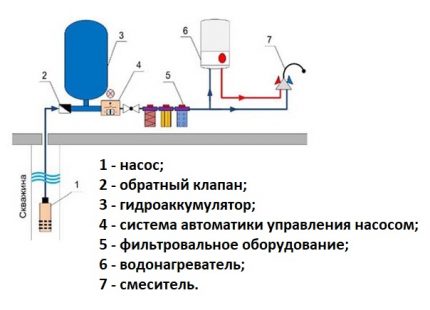
The nature of the arrangement of the well is largely determined by the type and place of installation of the water supply equipment. Consider the main options for completing the source equipment.
Shallow well surface pump
Surface pump Significantly cheaper, easier to install and maintain than submersible. The most rational and economically viable option is a three-in-one complete pumping station, which includes a surface pump, a relatively small (20-60 l) diaphragm tank, and all the necessary automation.
Only the suction hose is lowered into the well. Thus, the arrangement of the well and the maintenance of the pump are simplified. In addition, the hose has a small diameter, which allows it to be used in the so-called "Norton wells" (abyssinian wells), where the submersible pump just does not fit.
Pumping stations have only one, but a very significant drawback. The surface pump is not able to lift water from a great depth, for most models the limit is 8-10 m. This limits the scope of pumping stations to wells and shallow wells.
Due to the low lifting height, pumping stations with an upper pump arrangement often have to be installed as close to the wellhead as possible. Otherwise, you will have to additionally overcome the hydraulic resistance from the water source to the place in the house where the pump is installed.
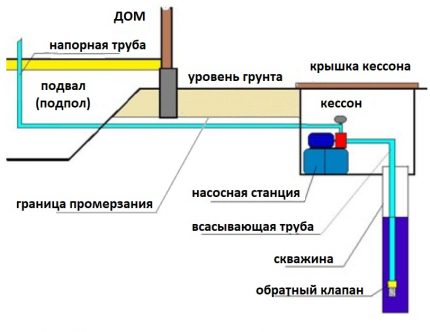
Deep well submersible pump
To raise water from wells with a depth of more than 10 m, submersible pumps have to be used. Choosing the right pump and determining its suspension height in the casing is a separate and rather difficult question.
As part of the topic of the article, we only need to understand what additional equipment the pump is equipped with, how it is mounted, connected.
As we have already mentioned, the essential elements of the water supply equipment of an individual house are accumulator and control automation. In the case of a submersible pump, the lifting height of which is several times greater than that of the surface pump, there are no restrictions on the installation location of the closed accumulator.
The membrane tank and control can be placed quite far from the wellhead; the distance to the source slightly affects the operation of the system. A great place to place equipment is a dry and clean technical room in the house, in the basement or on the ground floor.
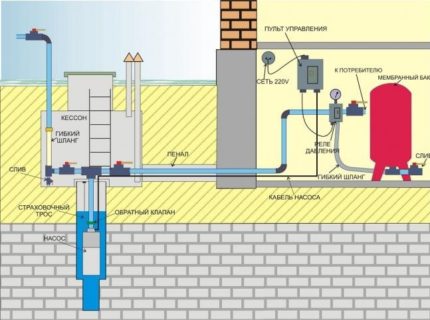
Weather well protection
To protect the source and equipment from atmospheric influences and precipitation, around the wellhead erect a protected room, placing it above the ground or below the surface of the earth:
Option # 1 - above-ground "house" -pavilion
At first glance, the easiest way is to put a small “house” pavilion over the water intake structure. It can be deepened a bit, like the entrance to a detached cellar, sprinkled with soil on both sides, making a kind of filling. This will reduce heat loss.
Similar pavilions are made over industrial wells. But at a private courtyard you will rarely see them. "House" takes a place on the site, clutters it, which is doubtful from an aesthetic point of view. In addition, the aboveground pavilion is not easy to effectively insulate.

Option # 2 - placing the source inside the building
Infrequently used, but quite rational technical solution for the arrangement water well - Placement of a water source in the basement of a residential building or inside an insulated utility building, a winter greenhouse, and a greenhouse. By the way, a very popular technique in the old days during the construction of stone buildings.
The well and equipment under the roof are reliably protected from all atmospheric influences, thieves and vandals. The installation and maintenance work is greatly simplified. The equipment does not create vibrations, from the noise - soft clicks when the relay is triggered. But they are practically inaudible outside the technical room with the door closed.
However, the placement of a well in a house or insulated hozblok is not common. This is explained by the fact that to implement this option, you must first drill a well, and only build a house over it. In our country, the vast majority of developers do the opposite.
Option # 3 - Underground Caisson Well
The most popular option of a protective room over a private well is a well. It will be right to call it a caisson; this is an adequate technical term. Caisson set in the ground good in that it does not clutter the area, on the surface we will see only a small hatch, located flush with the ground.
It is much simpler to warm an underground room than an above ground one; moreover, its lower part, located below the freezing depth, is in the zone of positive temperatures in winter, receiving a certain amount of heat from the ground. The problem is only waterproofing. The caisson can be purchased ready for installation or built independently.
The factory box is fully ready for installation. It is only necessary to open the pit and lower the tank to the desired mark. The caisson already has the necessary technological holes, it remains through the sealed cuffs to enter the communications in them: a water pipe and an electric cable.
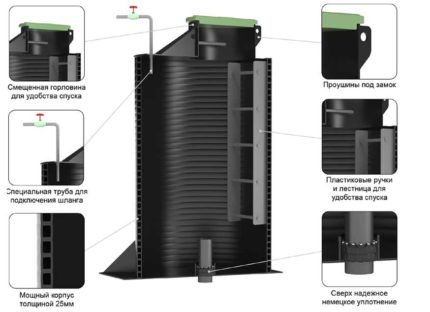
Ready-made caissons are made of steel or polymeric materials. Metal containers are stronger, not afraid of frost heaving, shock, can be installed in problematic soils, prone to displacement.
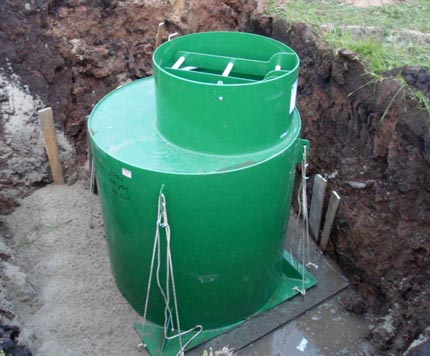
Plastic caissons are not subject to corrosion, almost do not form condensate on the inner surface. Unfortunately, factory caissons are not cheap. But they can be mounted in a few hours, issues of waterproofing are reliably resolved.

Caisson really build and own. Most likely, it will cost much cheaper than the factory. Perhaps it will be stronger. However, time and effort will have to spend a lot. The easiest option is to bury a couple of reinforced concrete well rings in the ground, covering them with a lid and a hatch with a neck.
The bottom will have to be concreted. It’s not easy to make reliable waterproofing reinforced concrete caisson. If you do it outside, it is better to use rolled bitumen material or high-quality mastic. However, you will have to dig out a too large pit to have access to the walls of the well.
It is possible to make insulation from the inside by carefully caulking the seams and smearing the inner walls, bottom and “ceiling” of the caisson with a polymer-cement composition.
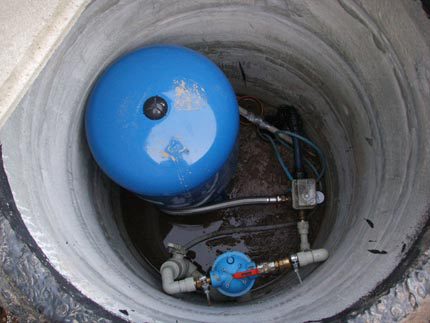
You can build a caisson on your own not only from factory rings. The design can be monolithic, brick (you need a well-fired red brick), you can use small-sized concrete blocks. A steel barrel decommissioned is also suitable.
Dimensions of the well protection structure
What should be the size of the caisson above the well? It depends on where the equipment will be installed. If in the house, dimensions of 80x80 cm are enough for the installer to “turn around”, lowering the pump.

When placing a pumping station or a separate membrane tank in the caisson we recommend adding 50 cm to the dimensions of the equipment on both sides (conditionally front and side). It is better, of course, if there are more places for service.
If we talk about concrete wells: the diameter of typical reinforced concrete rings is 90, 150 and 200 cm. 90 cm - the smallest possible size for a caisson without equipment, 150 cm - for a construction with equipment of moderate dimensions.
In a round two-meter well, a fairly large individual pumping station or a 200-liter hydroaccumulator can freely fit. The height of the caisson is the height of a person or two typical concrete rings.
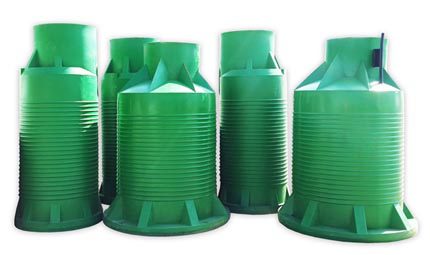
We also recall that in areas with severe winters, the bottom of the caisson should be located at least 15 cm below the freezing depth of the soil. Even better, if all of its lower third will be located in the ice-free zone.
Warming of the upper part is necessary, it is better to do it from the outside, but it is also possible from the inside. Any insulating material that does not suffer from moisture is suitable; extruded polystyrene foam is ideal.
Casing leak tightness
Neither dust nor condensation formed in the caisson nor rain or melt water should get into the casing of the well supplying the house with drinking water. If this happens, harmful microorganisms from the surface can get into a clean underground source and it will be difficult and expensive to “treat” it.
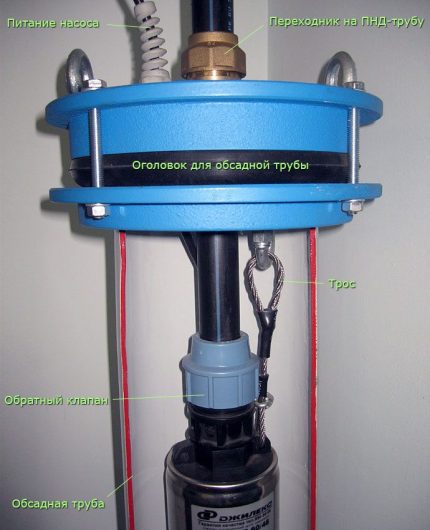
To protect the source serves well head - a special steel cover equipped with technological holes for passing communications and a reliable hook for hanging the pump. The head is selected according to the diameter of the casing; it has a rubber crimp cuff that seals the casing. A water pipe and an electric cable are also inserted through hermetic seals.
We do not recommend cutting the casing close to the caisson floor. It is better to leave a section 25-40 cm high above the concrete surface. Firstly, it will be more convenient to mount a pump with a head. Secondly, with a slight flooding of the caisson, water will not get into the wellbore.
Using a downhole adapter
A pavilion or caisson provides the best protection for the water supply. However, both of these solutions are by no means cheap. If we are talking about a solid country house and a vast plot, the noticeable financial costs of arranging the well are undoubtedly justified.
But what to do to the developer who does not have an infinite budget, is building a poor rural house or a modest cottage? To equip a well in a country house, there is an economical alternative solution - downhole adapter.
With its help, the water pipe coming from the house can be introduced directly into the casing of the well. No caisson is needed. True, if maintenance is necessary, the adapter will have to be excavated, because it is in the ground. But the need for this is rare.
The downhole adapter is a collapsible fitting, consisting of two parts: external and internal. The outer part is located outside the casing and serves to connect with a water pipe going into the house.
A pipe from the pump is connected to the mating internal part. Both parts of the adapter connected to the casing have a radius shape that repeats the diameter of the barrel. The elements are connected through a double tight seal.

The adapter must be located below the freezing depth of the soil and installation must be done with extreme care. The casing pipe remains on the surface of the earth, it is left slightly sticking out above ground level. A cover is mounted on top, into which an electric cable is inserted to power the submersible pump.
In severe frosts, cold will penetrate into the well through the casing. Therefore, if winter temperatures drop below -20 ° C, we recommend that you cover the well with spruce paws, straw, or warm it in another way for the winter.
The only, but significant advantage of the adapter over the caisson is low cost. Among the shortcomings: the complexity of equipment maintenance, poor protection from mechanical damage to the power cable, less reliable suspension of the pump (it does not rest on a cable, but on only a water pipe).
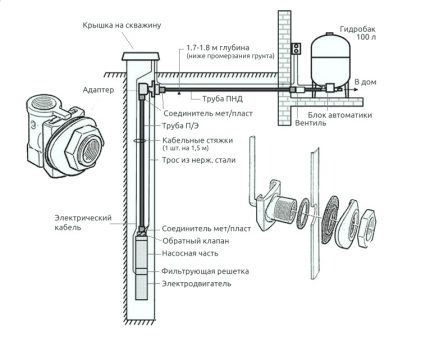
And yes, water supply equipment can only be installed in the house. You can mount the adapter yourself, but you will need a special key with a long nozzle, some technical skill and a lot of patience.
In conclusion, let’s say that a “cheap and angry” downhole adapter is really cheap. However, it cannot always be applied and does not provide the same level of source protection and durability as the caisson.
Well Design Tips
We hope that from the above, in general terms, it is clear how you can equip a well with your own hands.
Let us give readers some useful tips:
- If the groundwater level in the area is high and is located above the freezing depth of the soil, it is better to place a protective room on the surface, rather than underground. Or use an adapter.
- In a house with year-round living, try to place water supply equipment in the main building: a lot of space, warm and dry. It is convenient to service, equipment will last longer.
- Equipment for a seasonal home is best placed in the underground caisson. An unheated house will freeze, and a positive temperature will remain in the caisson. By the way, you must not forget to drain the water in the country house for the winter, if they have not been living in it for more than a week.
- In problematic soils (heaving, with crushed stone inclusions with sharp ribs, in quicksand), it is advisable to run the water pipe from the house to the caisson or adapter in a protective casing. The electric cable is always placed in the protective pipe PND.
- The connection of hydraulic equipment to the system is best done through shut-off valves with collapsible connections. If necessary, it will simply be serviced or replaced.
- Do not forget that, regardless of the type of equipment, the check valve should include a check valve after the pump and a coarse filter before the accumulator.
Among other things, during operation it is necessary to monitor the pressure level in the pneumatic element of the membrane tank. Check monthly, if necessary, pump.
Conclusions and useful video on the topic
Finally, videos that clearly demonstrate the process of arranging a source of groundwater.
Video # 1. The process of self-construction of an insulated caisson from concrete rings and the introduction of a water supply into the house:
Video # 1. Cost-effective well arrangement - self-installation of a downhole adapter:
Proper arrangement of an individual water supply source guarantees excellent water quality and eliminates problems with the repair and periodic maintenance of downhole equipment.
Those wishing to tell about their personal experience in arranging a well outside the suburban area are welcome to leave comments in the block below. Here you can share useful information on the topic and ask questions.

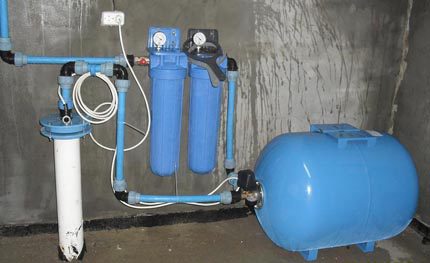
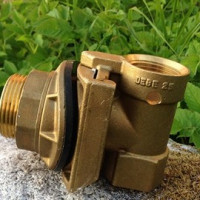 How to install an adapter for a well with your own hands: the best alternative to a caisson
How to install an adapter for a well with your own hands: the best alternative to a caisson  Do-it-yourself well without equipment: how to independently arrange a water source
Do-it-yourself well without equipment: how to independently arrange a water source  How to conduct water in a private house: arrangement of a source of water supply + water supply to the house
How to conduct water in a private house: arrangement of a source of water supply + water supply to the house 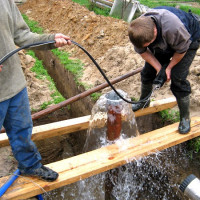 Do-it-yourself flushing of the well after drilling: step-by-step briefing on the work
Do-it-yourself flushing of the well after drilling: step-by-step briefing on the work  Do-it-yourself well cleaning: a review of common clogging causes and best cleaning methods
Do-it-yourself well cleaning: a review of common clogging causes and best cleaning methods  How to make water supply in the country from the well with your own hands: we carry water into the house
How to make water supply in the country from the well with your own hands: we carry water into the house  How much does it cost to connect gas to a private house: the price of organizing gas supply
How much does it cost to connect gas to a private house: the price of organizing gas supply  The best washing machines with dryer: model rating and customer tips
The best washing machines with dryer: model rating and customer tips  What is the color temperature of light and the nuances of choosing the temperature of the lamps to suit your needs
What is the color temperature of light and the nuances of choosing the temperature of the lamps to suit your needs  Replacement of a geyser in an apartment: replacement paperwork + basic norms and requirements
Replacement of a geyser in an apartment: replacement paperwork + basic norms and requirements
I'm just about to build a house on my site. I was really interested in the option of placing the well inside the house, while I have such an opportunity. The basement in my house is not provided, but there is a separate room for the boiler room. In it, a water well will be very useful, all the more I expect to put full automation on the water supply to the devices.
I do not advise placing the well under the house - after several years of operation, it can become silted up and then it must be purged with high pressure. At the same time, sludge with water is released onto the surface, dirt in the basement of the house will be knee-deep ...
Thank! very sensible article.